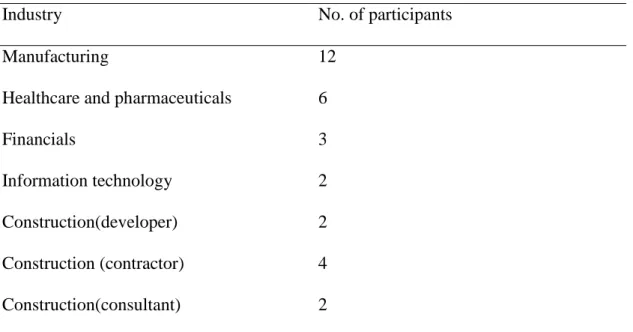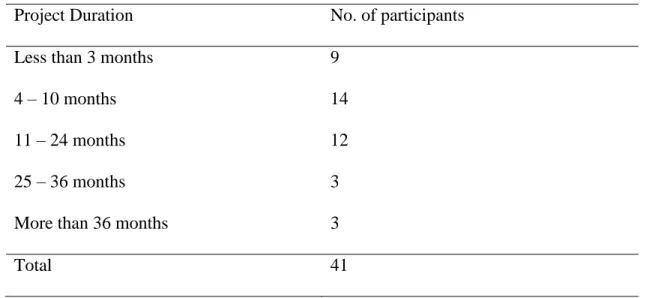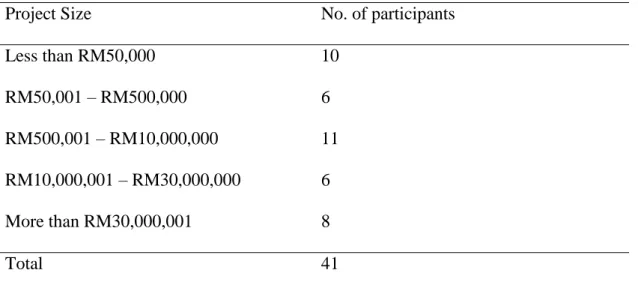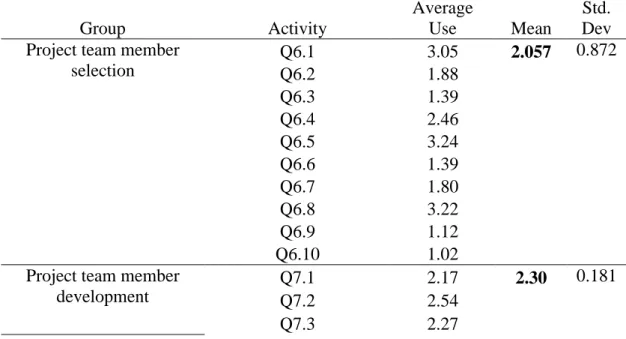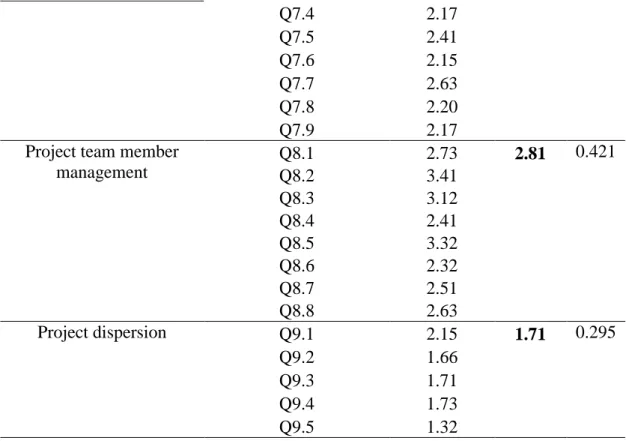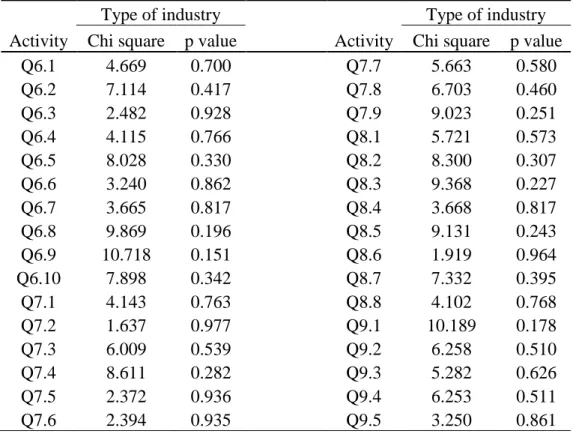I certify that this project report entitled “HUMAN RESOURCE MANAGEMENT IN THE PROJECT TEAM” prepared by LOW CHEN AUN has met the required requirements. In this research, project human resource management in project-oriented companies from different industries in Malaysia was studied.
Background
The companies that failed to utilize the potential of human resource management can lead to low productivity, high conflict and even high staff turnover. The way the company manages their human resource will ultimately affect the productivity of the company itself, therefore it is important for a company to manage its human resource carefully.
Problem Statement
Aim and Objectives
To examine the differences in human resource management practices for projects in different environments. To identify human resource management best practices for projects that can be adopted or adapted by other industries or project types.
Scope of the Research
Significance of the Research
Research Methodology
Spearman's correlation was used to find the relationship between activities and success factors while Krukal-wallis was used to find differences in terms of HRM activities performed between groups of respondents.
Structure of the Dissertation
This chapter is divided into different sub-headings, which include different ways of carrying out the research, descriptions of the participants and methods of analysis of the obtained data. The data collected in the survey is presented in tabular form for easy understanding and analyzed using SPSS to determine the relationship and differences in the data collected.
Summary
Introduction
Project Oriented Company
- Temporary Work Processes
- Dynamic Work Environment
- Project Portfolio Resource and Demands
- Specific Management Paradigm
Example of the above company would be an original equipment manufacturer that will manufacture a certain custom product for the customers. In any organization there will be a specific management culture related to dealing with things such as empowering the employees, process orientation, teamwork, continuous and discontinuous organizational change, customer orientation and networking with customers and suppliers (Gareis, 2005).
Features that a Project Oriented Company should have
Different companies have different cultures, so new staff need to be exposed to the culture through an induction process to learn how to deal with certain people, how things are done, and let the employee know what to expect. However, not all companies are completely project-oriented, some, such as a manufacturing company, do not use a project strategy for all operations, but for the development department, where they develop new strategies or production methods that can improve production processes.
Human Resource Activities in the Project Oriented Company
Assignment to Project
In addition, a project team is not complete without a project manager to lead the team, therefore it is important that a good project manager should be chosen carefully to lead the project team. Similar to selection practices, the project manager may be pre-assigned, hired from another organization, or nominated by the team members themselves.
Engagement on Project
This process is similar to an organizational recruitment process where employees in an organization are assigned to a project and their attitude in the project team is determined (Huemann et al., 2007). This process does not only take place during the initiation of the project/programme, it can also happen during the project life cycle (Eskerod . & Blichfeldt, 2005).
Dispersion after Project
Seminars and courses from outside companies are also one of the tools that can be used to develop the team members as they can learn new things, refresh old skills and also gain advanced information on various topics.
PMBOK Guide to Project Team Management
- Develop human resource plan
- Acquire project team
- Negotiation
- Pre-assignment
- Procurement
- Virtual Teams
- Team Development
- Team Building
- Training
- Ground Rules
- Collocation
- Reward and Recognition System
- Manage Project Team
- Observation and Conversation
- Project Performance Appraisal
- Conflict Management
- Issue Log
Clearly defining responsibilities will help keep the project both on budget and on schedule (Papke-Shields et al., 2010). Activities designed to enhance the competencies of the project team members can be formal or informal. In addition, with constant monitoring, the progress of the project, information on budget, schedule and quality is obtained from the feedback of the project team members, and the feedback can be used to increase the accountability of the members and motivate them to perform. more diligent (Bergen et al., 1992).
Summary
During the project, the problems that arise will be logged in a written document to help monitor who is responsible for solving specific problems by a target date (PMBOK, 2008). Next, Huemann's involvement in the project is similar to PMI's development project team and project team management, which emphasizes the development of the team members and management of the team members during the project. There are also differences between both sides, Huemann's literature includes the project dissemination activities, this is absent from PMI's literature.
Introduction
Literature review
Research Questionnaire
In addition, the questionnaire is aimed at all employees in an organization; it's not just for the HR managers.
Online Survey
Spearsman’s Ranking
In this research, Spearman's correlation coefficient will be used to determine the relationship between the activities performed and the project success factor. The relationship between the above items will show which activity affects which success factor and from there we will find out which activity can be done more to ensure a better chance of achieving a certain success criterion (to meet the fourth objective).
Kruskal-Wallis
In this research, Kruskal-Wallis will be used to compare the activities done by various groups of recipients, so that we can find out which activities are likely to be practiced by which types of populations (to achieve the third objective).
Cronbach’s Alpha
Introduction
From the table we can conclude that the activities in project team management were done the most, next are project team member development activities, and follow with project team member selection and project dissemination activities.
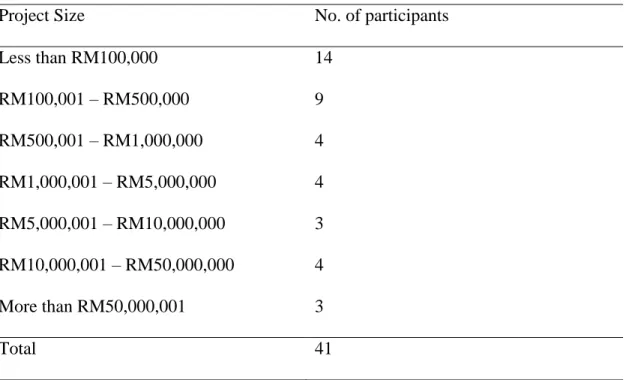
Reliability Test
Human Resource Management in Different Industries
Human Resources Management in Projects of Various Sizes
From the table, there is a difference between Q7.9 contribution is rewarded with promotion (p = 0.032), Q9.1 debriefing after completion of the project (p = 0.013) and Q9.2 advice on available job opportunities in the company (p = 0.013). The mean ranking from the Kruskal-Wallis test suggested that reward with promotion (m = 35.67) is more likely to be performed when the project size is more than 50 million. Besides that, post-project debriefing (m = 37.50) and counseling for job opportunities after project completion (m = 34.67) will also be more likely if the project size exceeds 50 million.
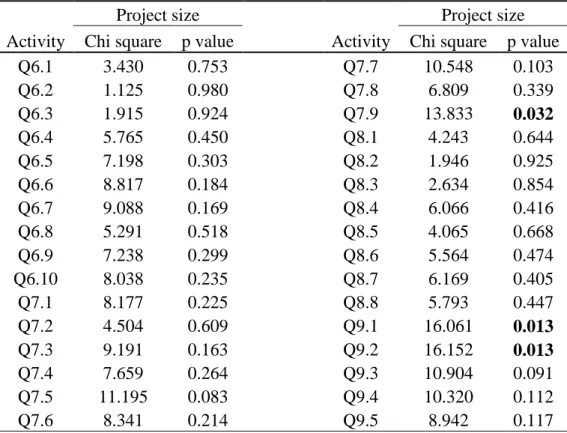
Human Resources Management in Projects of Different Duration
Human Resources Management in Projects with Different Number of Participants
The mean ranking from the analysis suggests that negotiations with staff to ensure that the project has competent staff (m = 28.67), and the activity of keeping team members on hold if there is no work (m = 28.54), have more likely to happen with a Team of 11-30 people. In a project team with more than 31 participants, employees are more likely to be hired from a remote location (m = 27.40), have non-computer-based classroom training (m = 32.50), and contributions of skilled employees are more likely to receive recognition with promotions (m = 31.50).
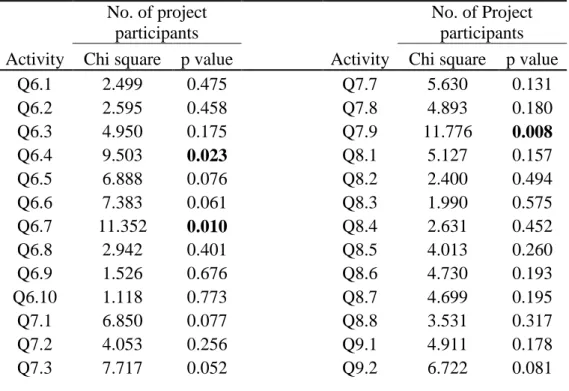
Human Resources Management in Companies with Different Annual Turnover
Correlations between Activities Performed and Success Factors
If the technical specification is met in Q10.3, there is a positive relationship with Q7.1. Team building activities are offered (rs = 0.337) and issues arise in Q8.8 that are recorded in a written document (rs = 0.310) with a 95% confidence level. In addition, we can also see from the table that there is a negative relationship between meeting customer expectations in Q10.4 and the project manager nominated in Q6.10 by team members (rs = -0.341) with a confidence level of 95 %, Q9.5 team members are suspended if there is no work in the near future (rs = -0.401) with a confidence level of 99%.
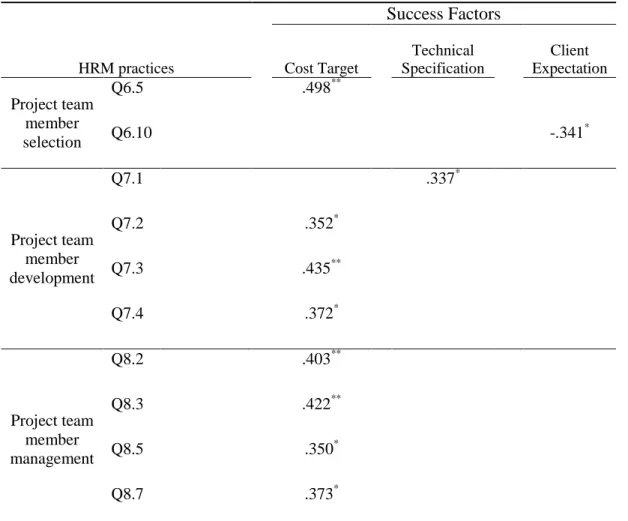
Do Companies Practice Project Human Resource Management?
Are There Any Factors Which Influence HRM Practice Use?
The Influence of Project Size on HRM Practice Use
The Influence of Project Duration on HRM Practice Use
The Influence of Number of Project Team Members on HRM Practice Use
For a larger project team, such as a construction project, team members who have demonstrated appropriate leadership skills will be promoted through a formally structured performance appraisal system (Raiden et al., 2004). The activity of suspending team members when there is no work usually happens with project teams of 11 to 30 members. This is because management may not be able to quickly reassign each member to another new project or engage in other types of activities. like training, because there are too many people and not enough tasks available. As a result, team members may be temporarily suspended pending any available task in the future.
The Influence of Company Annual Turnover on HRM Practice Use
As a result of this, the collected result showed that companies with higher annual turnover of more than RM30.1 million are less likely to rely on conversation (an informal method) only to resolve interpersonal issues. However, for companies with higher annual turnover, off-the-job training, which includes classroom lectures and seminars or courses, can be effectively used to develop technical and problem-solving skills (Tabassi & Bakar, 2009). Not only that, the result also showed that companies with a turnover of RM10.1 million to RM30 million are more likely to use chat to resolve interpersonal issues.
Relationship between HRM Practices and Meeting Cost Target
This is consistent with the result obtained; the use of e-mail and intranet in an organization will positively affect the cost objective of the project. With increased accountability of team members, there will be fewer mistakes during the project, mistakes will cost the project money because resources are needed to fix them. It is thus shown that monitoring the progress of the project has a positive relationship with meeting the cost target in the result.
Relationship between HRM Practices and Meeting Technical Specification
Training if there is no work in the near future is negatively related to achieving target costs. This is because training involves a fixed amount of costs such as instructor salary, classroom costs, and variable costs such as student materials (Blakenhorn, 1999). Consequently, the use of a problem log is positively associated with meeting technical specifications.
Relationship between HRM Practices and Meeting Client Expectation
And so team members who are kept on hold if there is no work in the near future are negatively associated with meeting customer expectations. The findings are summarized and concluded in this chapter, besides the limitations of the research and further recommendations for improving the research are also included in this chapter.
Summary
The various characteristics of a project-oriented company can include a temporary work process, a dynamic work environment, the resources and requirements of the project portfolio, and a specific management paradigm (Schuler, 1996). Next, what are the human resource processes in a project-oriented company, the differences between the HRM process in a project-oriented company and a non-project-oriented company. There are more activities involved in a project-based company, this includes assignment to projects, involvement about project, and post-project dissemination (Huemann, et al., 2007). Kruskal-Wallis was used to determine whether or not there were differences in the practices performed by the different groups of participants.
Conclusion
Next, activities that are positively related to meeting technical specifications include assured team building activities and the use of a problem log. Finally, two activities were found to be negatively related to meeting customer expectations, namely project team members being nominated by team members and team members being held back when there is no work in the near future. Go through the training if there is no job in the near future Computer training.
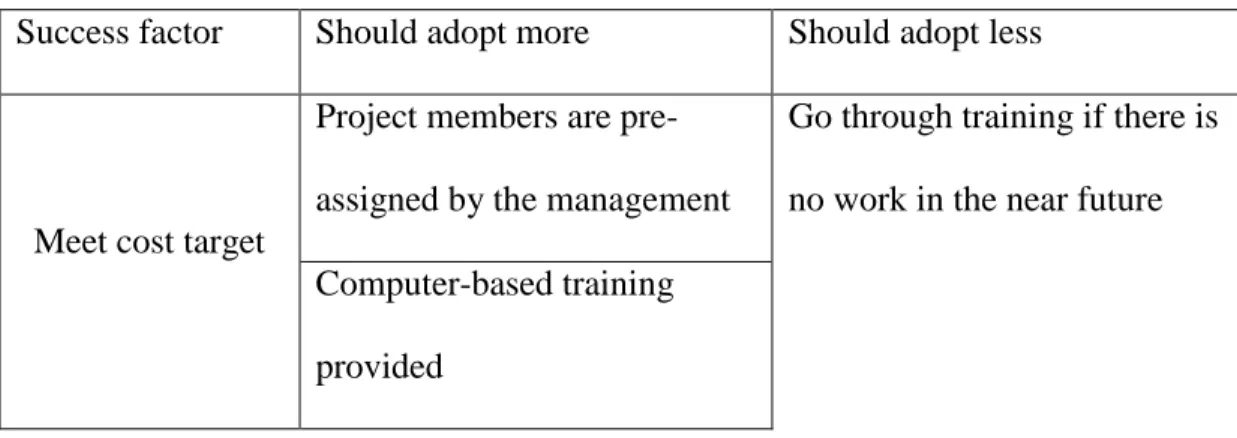
Limitations of the Research
Further Research
Human resource retention can also be examined as it has rarely been mentioned in any project HRM literature. The dynamic nature of the project requires employees to work outside their comfort zone, which can lead to high turnover. The Impact of HRM Practices on Operational Performance: Identifying Country and Industry Differences.
Training, motivation and performance: A case of human resource management in construction projects in Mashhad, Iran.
